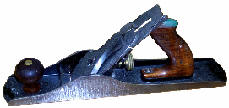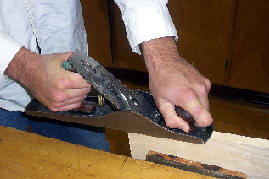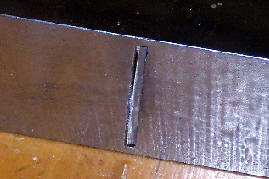Jack Hand Plane
|
|
The jack plane is one of the most versatile machines used for hand tool woodworking. It can be used for a This sheet describes the procedure for hand plane a stock to width. For other operations ask your instructor or refer to one of the many texts available. |
Controls: The controls on the jack plane in the materials processing laboratory consist of the following:
- Jack plane handle used to push the jack along the surface of the stock..
- Jack plane toe is used to apply downward pressure into the stock.
- Jack plane lateral adjusting level is used to change the depth of the blade by adjusting the cam cap level and the nut.
Note: There are other controls on different jack planes that may not be listed in this reference.
Operation (Planing): Planing is the operation during which the plane is being pushed into the stock.. Refer to the following illustrations.
- Insert piece of wood in vise and clamp tightly.
- Grasp the rear handle of the plane in one hand, with the index finger pointing forward.
- Grasp the front handle with the thumb and forefinger of the other hand, or you may lay the palm of that hand firmly over the handle.
- Position yourself firmly at the back of the wood in the vise.
- Lay the toe of the blade on the wood and slide the plane forward, exerting pressure on both the toe and heel. If the blade is protruding too far, readjust depth by turning adjusting nut in a counterclockwise direction.
- Once you have reached the end of the wood, remove pressure from the toe and return plane to starting position. Repeat stroke, making sure that you are planing the edge of the wood, not its corners.
- If the wood begins to chip apart, remove it from the vise and turn it around. You have been planing against the grain
- Repeat planing strokes several times until you can make one long, clean shaving, which should be paper thin
- Planing the end grain of the wood is a little trickier. First, turn wood over so end-grain is up, and tighten vise securely.
- Grasp the plane as before, but do not attempt a single-length cut. Plane halfway on the edge, and then turn the piece of wood around in the vise, and plane in from that end to the center.
Repeat these steps on several pieces of wood until you are really in control of the tool.
Note: There are several other operations that can be done using a jack plane. Ask your instructor and refer to one of the many references for those procedures.
|
|
|
|
The blade is being pushed into the stock without taking to deep of a cut. Note the position of the stock being above the clamping device . |
When checking the blade view the depth of the blade to the surface of the planer and the sharpness of the cutting blade. |
Potential hazards: Because of the sharp blade of the hand planes, the following hazards exist.
- Any contact with the blade could cause severe injury.
- Clothing or other articles that contact the blade could become entangled and pull the operator into the blade.
- The work piece can be thrown (kicked back) violently if not clamped down properly..
- Small pieces of the work piece and saw dust can be thrown out at the operator.
- The operator could slip and fall.
Safety practices: Because of those potential hazards the following safety rules must be followed.
- Be sure to perform only operations you know how to do safely.
- Always wear safety glasses.
- Never wear cloths or other articles that dangle and could catch on the saw.
- Be sure to have firm footing.
- Check the planer to make sure it is in good working order.
- Check the stock for foreign objects.
- Avoid distractions, never look away during a plane.
- Do not allow others to crowd around the operation.
- Always have stock clamped in position when using the hand plane.
- Keep both hands and feet behind the cutting edge.
- Keep the plane iron sharp.
- Do not try to take to deep of a cut.
- Be sure the screwdriver does not slip when tightening or loosening the iron-cap screw.
References:
William p. Spence, L.Duane Griffiths,. (1981). Woodworking (Tools ,Materials, Processes). By: American Technical Publishers INC.
Herman Hjorth, Ewell W. Fowler. Basic Woodworking Processes. The Bruce Publishing Company. Milwaukee, Wisconsin
Brown & Tustison.(1930). Instructional Units in Hand working. The Bruce Publishing Company. Milwaukee, Wisconsin.
ITT 252 - Materials Processing
Department of Technology
University of Southern Maine
Prepared by Darren Cornell, 12/6/2002


